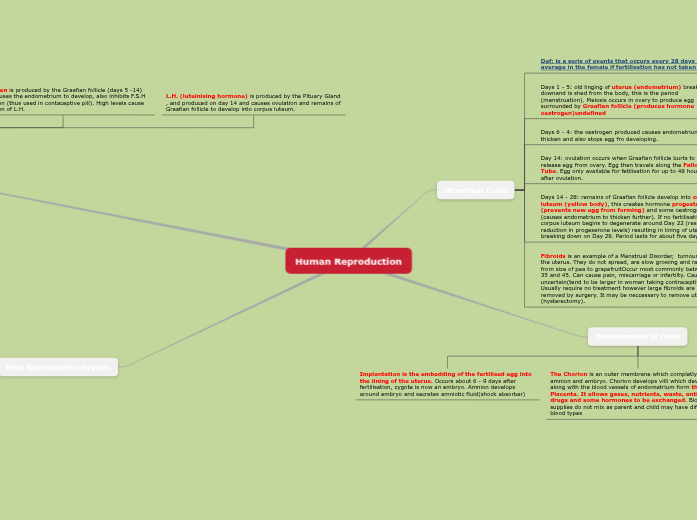Human Reproduction
Menstrual Cycle
Def: is a seris of events that occurs every 28 days on average in the female if fertilisation has not taken place
Days 1 - 5: old linging of uterus (endometrium) breaks downand is shed from the body, this is the period (menstruation). Meiosis occurs in ovary to produce egg surrounded by Graafian follicle (produces hormone oestrogen)undefined
Days 6 - 4: the oestrogen produced causes endometrium to thicken and also stops egg fro developing.
Day 14: ovulation occurs when Graafian follicle burts to release egg from ovary. Egg then travels along the Fallopian Tube. Egg only available for fetilisation for up to 48 hours after ovulation.
Days 14 - 28: remains of Graafian follicle develop into corpus luteum (yellow body), this creates hormone progesterone (prevents new egg from forming) and some oestrogen (causes endometrium to thicken further). If no fertilisation corpus luteum begins to degenerate around Day 22 (results in reduction in progeserone levels) resulting in lining of uterus breaking down on Day 28. Period lasts for about five days.
Fibroids is an example of a Menstrual Disorder, tumours of the uterus. They do not spread, are slow growing and range from size of pea to grapefruitOccur most commonly between 35 and 45. Can cause pain, miscarriage or infertilty. Cause is uncertain(tend to be larger in woman taking contraceptive pill. Usually require no treatment however large fibroids are removed by surgery. It may be neccessary to remove uterus (hysterectomy).
Development of Child
Implantation is the embedding of the fertilised egg into the lining of the uterus. Occurs about 6 - 9 days after fertilisation, zygote is now an embryo. Amnion develops around embryo and secretes amniotic fluid(shock absorber)
The Chorion is an outer membrane which completly surround amnion and embryo. Chorion develops villi which develop along with the blood vessels of endometrium form the Placenta. It allows gases, nutrients, waste, antibodies, drugs and some hormones to be exchanged. Blood supplies do not mix as parent and child may have different blood types
Zygote develops by mitosis ( it consists of 46 chromosomes half from each parent), and after three days forms the Morula ( solid ball of cells) and after 5 it forms a hollow ball of a few hundred cells to form a Blastocyst. Outer cells then form Trophoblast (will later form membranes around the embryo. undefined
Female Reproductive System
Def: ovulation is the release of an egg in the ovary
Ovaries produce eggs and female hormones. Eggs produced by meiosis. Puberty = 11 - 12 . Ovaries can contain up to 1 mil eggs at birth, this is a finite amount, by puberty only about 40000 remain. 20 eggs produced meiosis each month.
Egg is moved by peristalsis and cilia in the Fallopian tubes. Opening of uterus is called the cervix.
Female infertilty occurs due to failure to ovulate beacuse of hormone disorder, stress, or a tumour. Hormonal treatment can be given, stress relief or surgery on the ovary. In vitro fetilisation can be used to achieve fertilisation.
F.S.H. is produced by the Pituary Gland and early in the Mentsrual Cycle (days 1 - 5). It stimulates eggs to develop surrounded by Graafian follicles.
Oestrogen is produced by the Graafian follicle (days 5 -14) and it causes the endometrium to develop, also inhibits F.S.H production (thus used in contaceptive pill). High levels cause production of L.H.
L.H. (luteinising hormone) is produced by the Pituary Gland , and produced on day 14 and causes ovulation and remains of Graafian follicle to develop into corpus luteum.
Male Reproductive System
Def: a gonad is an organ that produces sex cells in animlas
Male gonads = testes. Contained in scrotum and is maintained at 35*C (meiosis can occur producing sperm). Testes contain coild mass of tubules lined with diploid sperm producing cells. Cells located between tubules produce testosterone).
Tubules in testes combine to form epididymis (located outside each testis). Mature sperm stored here for up ti 6 weeks. If not released they are broken down in epididymis and taken to bloodstream (resorption).
Epididymis leads to sperm duct (vas deferens).
Vasectomy = operation to cut sperm ducts. Sperm ducts carry sperm to urethra (tube located in centre of penis), has dual functions of urine or sperm.
Seminal Vesicles + Prostate Gland + Cowper's Gland produce seminal fluid.
Seminal fluid + sperm = semen.
Def: ejaculation is the release of semen drom the penis
Sperm cells are first produced at puberty (12 - 13).
Swollen tip of penis = glans.
Foreskin partially covers glans, cicumcision is removal of foreskin.
F.S.H (follicle stimulating hormone) cause sperm producing cells in testes to divide by meiosis.
L.H. (luteininsing hormone) stimulates testes to produce testosterone.
Androgens = male hormones.
Testosterone causes primary male sex characteristics in early life ( growth of male reproductive parts). Increases during puberty. Also causes secondary male characteristics (growth of body hair, enlargement of larynx, increased muscular and bone development, increased secretion of sebum etc)
Male infertiley is the inability to produce offspring. Occurs due to low sperm count (because of cmoking, alcohol abuse, marijuana, steroids, mumps in adult life. Treatment = change in diet and lifestyle, if due to hormones then relevent hormone may be introduced.
